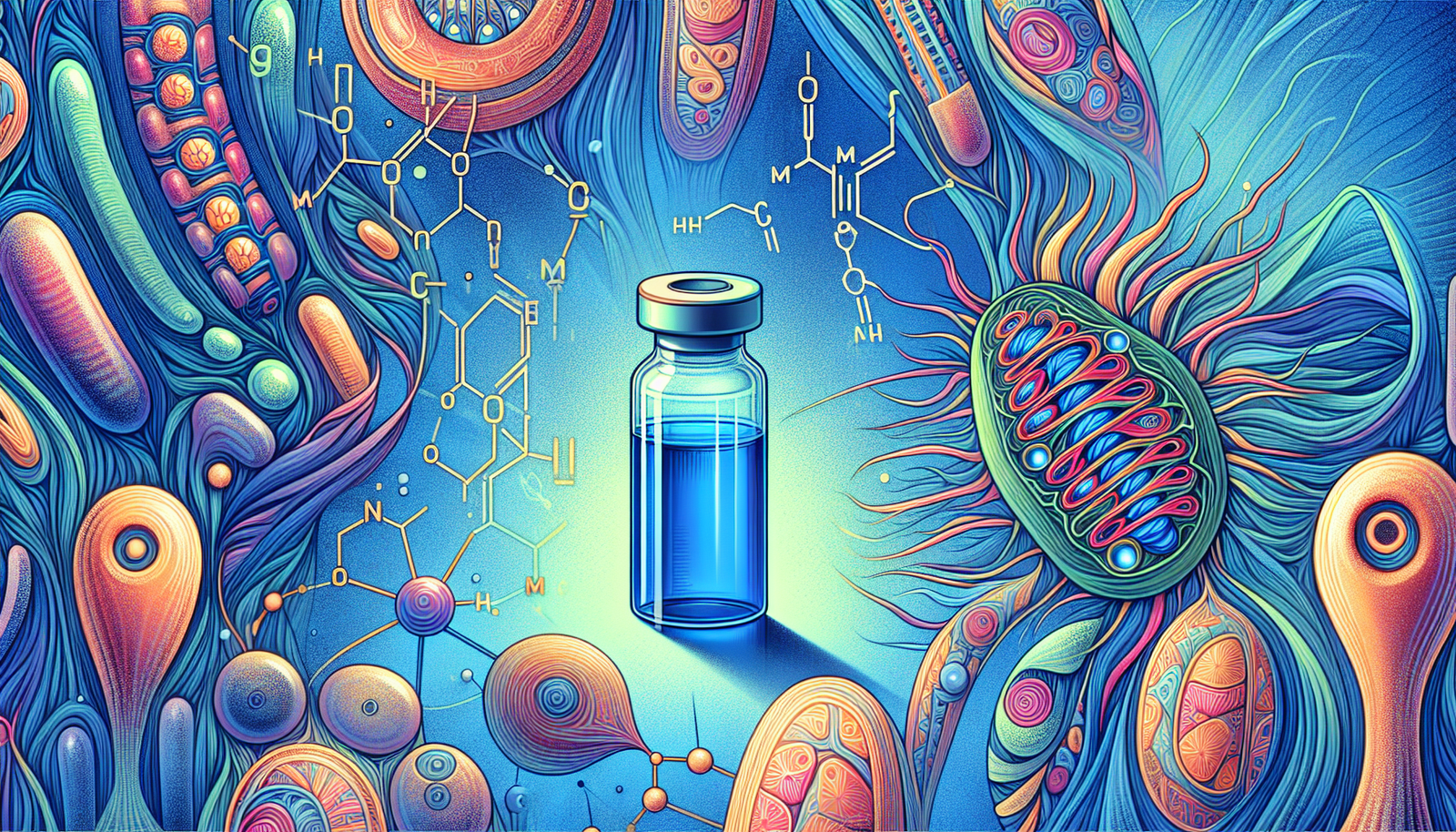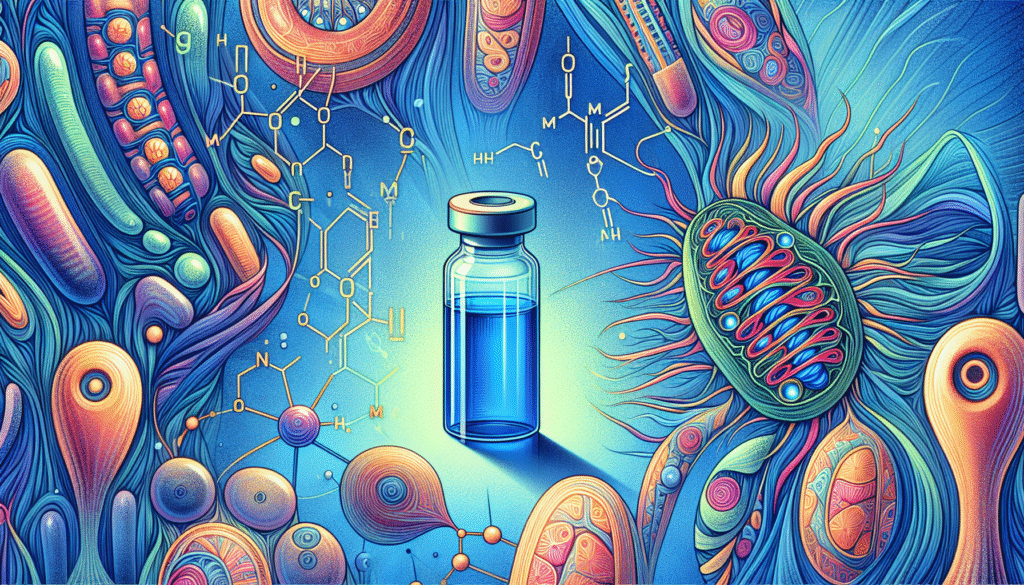
Have you ever considered how a seemingly simple dye could play a significant role in your cellular health? Methylene blue, known for its applications in various fields, has garnered attention in recent years for its intriguing connection to mitochondrial function. This article aims to elucidate the complex relationship between methylene blue and mitochondria, shedding light on the potential implications for health and wellness.

What is Methylene Blue?
Methylene blue is a synthetic dye that has been utilized in various domains, from textile dyeing to medical applications. Its chemical structure consists of a thiazine ring, which gives it a blue color, and it has been used as a stain in microbiology, as a treatment for methemoglobinemia, and more recently, in neurobiology and mitochondrial research.
Chemical Composition
The formula of methylene blue is C16H18ClN3S, and its molecular weight is approximately 319.85 g/mol. This compound exhibits unique properties that lend themselves to numerous applications, including its role as an electron donor in biological systems.
Historical Perspective
Discovered in the 19th century, methylene blue was initially utilized as a dye. It transitioned into medicinal use with the realization that it had therapeutic properties. Its impact on biological systems has sparked interest, particularly regarding its function in cellular respiration and mitochondrial activity.
Mitochondrial Function Explained
Mitochondria are often referred to as the powerhouses of the cell. They are organelles that convert nutrients into adenosine triphosphate (ATP), the energy currency of the cell. Understanding mitochondrial function is crucial to grasping why methylene blue is of interest in biomedical research.
Energy Production
Mitochondria produce ATP through a process known as oxidative phosphorylation. This process involves the electron transport chain (ETC), a series of complexes embedded in the inner mitochondrial membrane that facilitate electron transfer to ultimately generate ATP.
- Glycolysis: Glucose is broken down in the cytoplasm to produce pyruvate, leading into the mitochondria.
- Krebs Cycle: Pyruvate is transformed in the mitochondrial matrix, generating electron carriers NADH and FADH2.
- Electron Transport Chain: Electrons are transferred through complexes I-IV, driving protons (H+) across the membrane and creating a proton gradient.
- ATP Synthase: The flow of protons back into the matrix through ATP synthase drives the conversion of ADP to ATP.
Regulation of Metabolism
Mitochondria are responsible not only for energy production but also for regulating metabolic processes, apoptosis (programmed cell death), and cellular signaling. Their influence extends to how your body metabolizes nutrients and responds to physiological stressors.
Methylene Blue’s Mechanism of Action
Methylene blue exerts its effects on mitochondrial function primarily through two mechanisms: acting as an alternative electron carrier in the ETC and possessing antioxidant properties.
Alternative Electron Carrier
Drawing from its chemical structure, methylene blue can accept and donate electrons. In situations where the ETC is impaired, methylene blue can facilitate electron transfer, effectively bypassing dysfunctional components of the chain.
For instance, when complex IV is inhibited, methylene blue can accept electrons from complex I and II and donate them upstream, thereby maintaining ATP production even in compromised mitochondrial function.
Antioxidant Properties
Methylene blue also exhibits antioxidant properties, which help to mitigate oxidative stress—an imbalance between reactive oxygen species (ROS) and antioxidant defenses. Oxidative stress is linked to various pathologies, including neurodegenerative diseases, cardiovascular issues, and aging.
Through reducing the levels of ROS, methylene blue contributes to preserving mitochondrial integrity and function.
Implications for Health
The potential health benefits of methylene blue in relation to mitochondrial function are extensive. Research has indicated its promise in treating conditions ranging from neurodegeneration to metabolic disorders.
Neurodegenerative Diseases
Mitochondrial dysfunction is a hallmark of various neurodegenerative diseases such as Alzheimer’s and Parkinson’s. Methylene blue has been studied for its neuroprotective properties, primarily due to its ability to enhance mitochondrial function and reduce oxidative stress.
Alzheimer’s Disease
In models of Alzheimer’s disease, methylene blue has shown the ability to mitigate cognitive decline by improving mitochondrial function, thus enhancing energy metabolism in neurons.
Parkinson’s Disease
In Parkinson’s models, methylene blue has been demonstrated to improve motor function and reduce dopaminergic neuron loss, primarily through mechanisms that enhance mitochondrial bioenergetics and reduce apoptosis.
Cardiovascular Health
Mitochondrial dysfunction contributes to various cardiovascular diseases. Research indicates that methylene blue can improve cardiac output and enhance mitochondrial function in heart tissues. Its role in modulating oxidative stress may also contribute to the protection of heart cells.
Metabolic Disorders
For individuals with metabolic disorders like diabetes, maintaining mitochondrial health is crucial. Methylene blue’s ability to enhance mitochondrial function may help in improving insulin sensitivity and glucose metabolism, thereby potentially providing a therapeutic avenue for metabolic syndrome management.

Dosage and Administration
Determining an appropriate dosage for methylene blue can be complex, as it varies based on the intended application and individual patient factors.
General Considerations
- Methylene blue is administered in various forms, including intravenous and oral routes.
- Dosages in research settings typically range from 0.5 to 4 mg/kg per day, depending on the condition being treated.
- It is crucial to consult with a healthcare professional before beginning any treatment regimen involving methylene blue.
Precautions
While methylene blue is relatively safe, it possesses contraindications. It should be avoided in individuals with G6PD deficiency and those taking serotonergic medications, as it can induce serotonin syndrome.
Side Effects and Risks
Understanding the side effects and risks associated with methylene blue is essential for informed decision-making.
Common Side Effects
- Nausea: Some individuals may experience gastrointestinal disturbances.
- Headache: This may occur, particularly with higher doses.
- Skin Discoloration: Methylene blue can cause temporary bluish discoloration of the urine and skin.
Serious Risks
While rare, serious side effects may include:
- Hypertension: Methylene blue can elevate blood pressure in some individuals.
- Serotonin Syndrome: When combined with certain medications, this can occur.
recognizing these risks and discussing them with a physician ensures safe usage.
Current Research and Future Directions
Research on methylene blue is expanding rapidly, particularly regarding its application in neuroprotection and mitochondrial health. Ongoing clinical trials and studies aim to establish definitive outcomes for its therapeutic use.
Key Areas of Exploration
Enhancing Cognitive Function
Investigations into methylene blue’s capacity to boost cognition continue to be promising. Studies aim to quantify improvements in memory and learning in various populations, including the elderly and individuals with cognitive impairments.
Chronic Pain Management
Emerging studies suggest the potential role of methylene blue in managing chronic pain conditions linked to mitochondrial dysfunction. Understanding its mechanistic pathways could inform new treatments.
Aging Research
Methylene blue’s properties are being explored in the context of aging. By targeting mitochondrial health, it may offer strategies to dampen age-related decline, enhancing both lifespan and healthspan.
Conclusion
The multi-faceted roles of methylene blue, particularly concerning mitochondrial function, present exciting possibilities for enhancing health outcomes. As research progresses, understanding how this compound can influence cellular energy production, mitigate oxidative stress, and potentially aid in various diseases may unveil new therapeutic avenues.
As with any compound, diligent research, personalized clinical approaches, and a thorough understanding of its implications are paramount in harnessing the benefits of methylene blue for enhancing mitochondrial health. Consulting with healthcare professionals and remaining informed about ongoing research is crucial for ensuring safe and effective treatment options.
Methylene blue exemplifies the potential of seemingly simple compounds to impact complex biological processes profoundly. As conversations around cellular health and mitochondrial function continue to evolve, so too does the significance of exploring all available avenues, including those positioned at the intersection of research, medicine, and patient care.